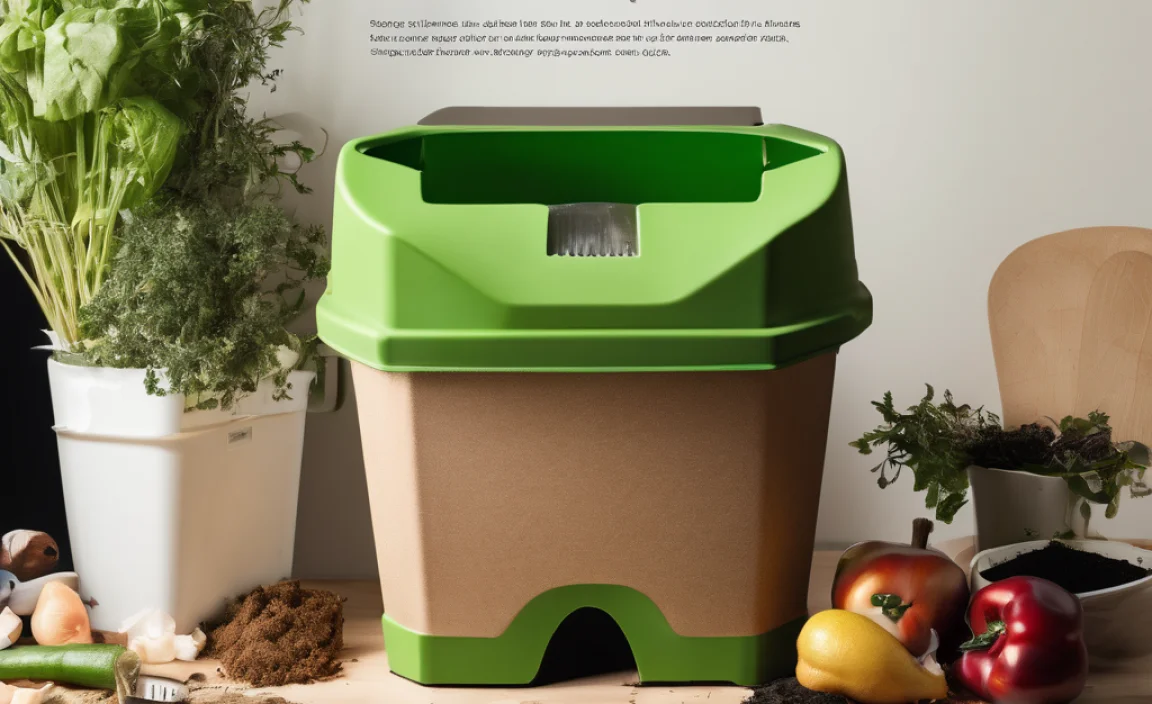Have you ever wondered what happens to your banana peels and apple cores? Instead of tossing them in the trash, you can turn them into rich soil. How? With indoor composting! This indoor composting guide will show you how to transform kitchen scraps into something useful. You’ll learn simple steps to start composting right at home. It’s a fun way to help the environment and see nature’s magic at work.
Key Takeaways
- Indoor composting turns food scraps into rich soil.
- You need a bin, food scraps, and patience.
- This indoor composting guide offers easy steps to follow.
- Composting helps reduce kitchen waste and benefits plants.
- Even small spaces can support indoor composting.
Getting Started With Indoor Composting
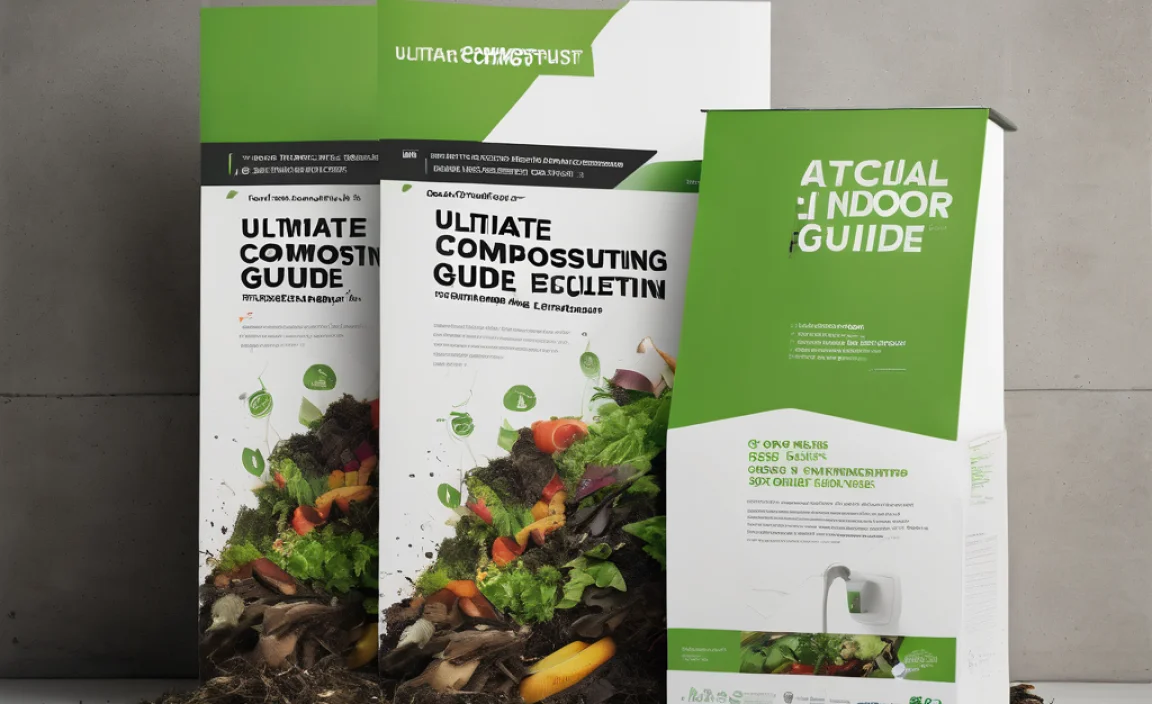
Indoor composting is a great way to recycle food scraps. Do you have a small space? No problem! You can compost indoors with minimal supplies. First, find a container to use as your compost bin. It could be an old plastic tub or a fancy compost bin. Make sure it has a lid to keep odors in and pests out. Next, gather your food scraps. Things like fruit peels, coffee grounds, and eggshells work well.
- Choose a container with a lid.
- Collect food scraps daily.
- Add some soil to start.
- Keep the bin in a warm spot.
- Stir the compost every few days.
- Check moisture levels regularly.
- Use finished compost on plants.
Once you have your materials, it’s time to start composting! Place a layer of soil in the bottom of your container. Add your food scraps on top. Try to mix in different types of scraps for balance. Stir the compost every few days to speed up the process. Keep it moist but not soggy. Soon, you’ll have rich compost to use for your plants. Fun Fact or Stats : Composting can reduce household waste by up to 30%.
Choosing the Right Container
What container should you use for composting? Any container with a lid can work. You might have a suitable bin at home already. If not, you can buy one at a store or online. Make sure it’s the right size for your space. Some people use special worm bins for composting. These bins have worms that help break down the food faster. Worms might sound a bit yucky, but they do a great job!
What Can You Compost Indoors?
You might wonder what types of scraps are suitable for composting. You can compost things like vegetable peels, fruit rinds, and coffee grounds. Eggshells are okay too. Avoid meat, dairy, and greasy foods. They can create bad smells. Keeping a balance of “greens” and “browns” helps. Greens are fresh scraps, while browns are dry items like paper. This balance aids the composting process.
Maintaining Your Compost Bin
How often should you check your compost bin? It’s a good habit to look at it once a week. Ensure it’s not too wet or too dry. Stirring helps mix the scraps and speeds up decomposition. If you notice a bad smell, add more browns. If it’s too dry, sprinkle some water. Regular maintenance keeps your compost healthy.
Understanding the Composting Process
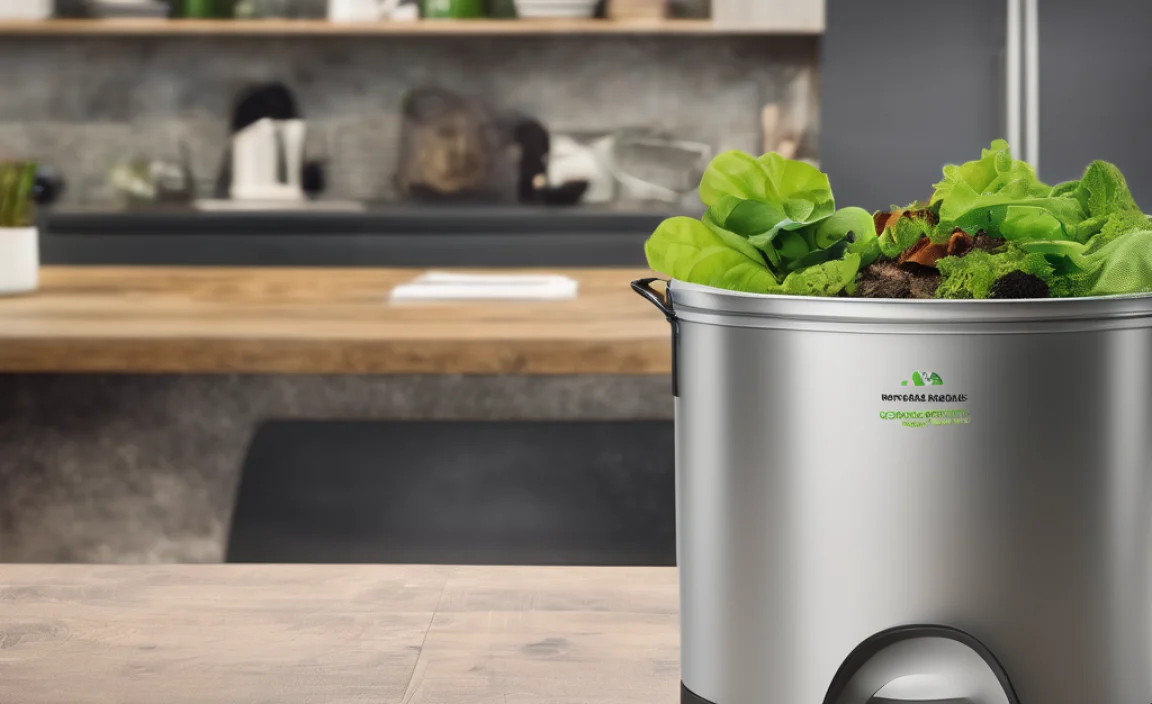
Composting turns waste into soil through a natural process. Tiny organisms, like bacteria and fungi, break down food scraps. This creates heat and eventually turns scraps into soil. It might take a few weeks to a few months. What will you do with your finished compost? You can use it to enrich the soil in houseplants or garden beds. It helps plants grow strong and healthy.
- Microorganisms break down the scraps.
- Composting generates heat naturally.
- The process takes several weeks.
- Finished compost enriches plant soil.
- Composting reduces food waste.
- Healthy soil supports plant growth.
- Use compost indoors or outdoors.
During composting, keep an eye on the progress. The compost should feel warm and smell earthy, not rotten. If it’s not, add different types of scraps or adjust moisture. Over time, you’ll see the scraps turn to dark, crumbly soil. This is your finished compost, ready for use in your garden. Fun Fact or Stats : One pound of food waste can create about half a pound of compost.
The Role of Microorganisms
Who are the tiny heroes in your compost bin? Microorganisms! These tiny creatures help break down food scraps. They need air, moisture, and warmth to thrive. As they work, they produce heat, which speeds up composting. Without them, composting would take a lot longer. By stirring your compost bin, you help them get the air they need. It’s like giving them a little boost to keep going strong.
The Importance of Balance
Why is balance crucial in composting? Just like a balanced diet helps us stay healthy, a balanced compost bin works better. You need a mix of “greens” and “browns.” Greens provide nitrogen, while browns add carbon. Both are essential for decomposition. If your compost smells or doesn’t break down, check the balance. Adjusting the mix can solve many composting issues.
Harvesting and Using Compost
How do you know when your compost is ready? Finished compost looks dark and crumbly. It smells earthy, not like rotten food. It should be ready to use in a few weeks to months. Spread it on top of plant soil or mix it in. Compost helps plants grow by providing nutrients. It improves soil structure and retains moisture. Using your compost feels rewarding and beneficial.
Comparing Indoor Composting Methods
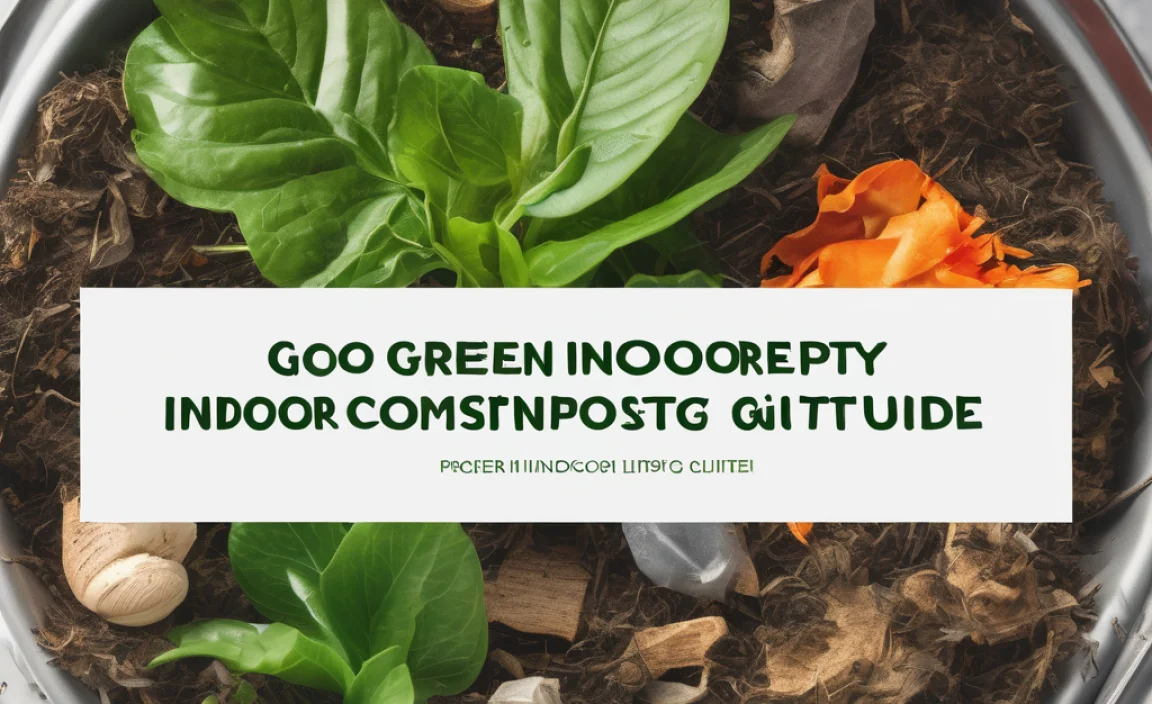
There are different methods for indoor composting. Each has its pros and cons. You can choose based on space, effort, and preference. The two most common methods are traditional bin composting and vermicomposting. Both are effective but have differences. Let’s compare them to see which suits you best.
| Method | Pros | Cons |
|---|---|---|
| Traditional Bin | Easy setup | Slower process |
| Vermicomposting | Faster results | Requires worms |
| Bokashi | Handles meat | Needs special mix |
| Electric Composter | Quick and easy | Expensive |
- Traditional bin composting is simple.
- Vermicomposting uses worms for faster results.
- Bokashi composting can handle more scraps.
- Electric composters are quick but costly.
- Each method has unique benefits.
- Choose based on space and needs.
- Experiment with different methods.
Most people start with traditional bin composting. It’s straightforward and doesn’t need special equipment. Vermicomposting is faster but requires worms. Bokashi can handle foods like meat and dairy but needs a special mix. Electric composters are fast but expensive. Try different methods to see what works best for you. Fun Fact or Stats : Worms can eat their weight in food each day!
Traditional Bin Composting
How does traditional bin composting work? It’s the most common method. Find a bin with a lid. Add layers of food scraps and soil. Stir to keep everything mixed. It takes time but is simple. This method is great if you have patience and space. The result is nutrient-rich compost for your plants.
Vermicomposting with Worms
Are worms good for composting? Absolutely! Vermicomposting uses worms to break down food faster. You need a special bin with air holes. Add bedding like shredded paper. Then, introduce the worms. They eat the scraps and leave behind nutrient-rich castings. Worms speed up composting and create excellent soil. It’s great for those who don’t mind wiggly helpers.
Bokashi Composting
Have you heard of Bokashi composting? It’s different from traditional methods. Bokashi uses a special mix to ferment scraps. It can handle foods like meat and cheese. After fermentation, the scraps break down in the soil. This method is faster and doesn’t smell. It’s perfect if you want to compost more types of food.
Troubleshooting Common Issues
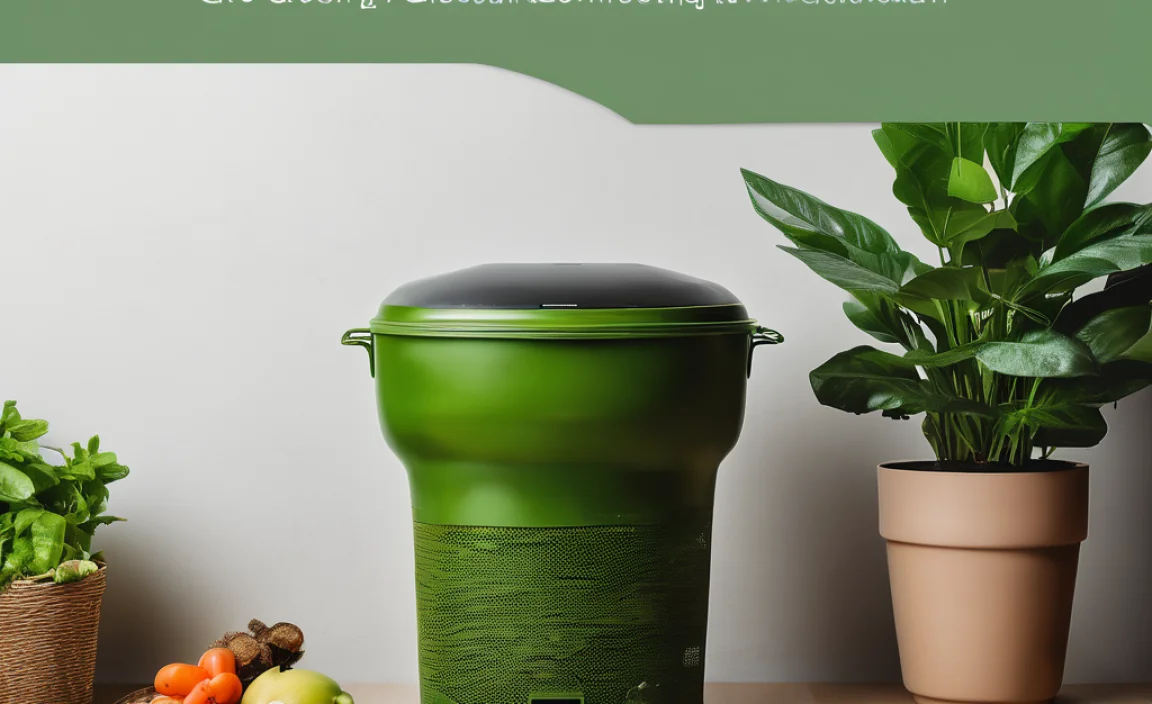
Even with the best plans, things can go wrong. Composting might hit a snag. Maybe it smells bad or isn’t breaking down. Don’t worry! Many issues have simple fixes. Let’s look at common problems and solutions. With a little adjustment, your compost bin will be back on track.
- Bad smell? Add more browns.
- Too slow? Stir more often.
- Too wet? Add dry material.
- Pests? Secure the lid tightly.
- No heat? Mix in fresh scraps.
- Scraps not breaking down? Check balance.
- Bin too dry? Sprinkle with water.
First, if your compost smells bad, it might have too many greens. Add more browns like paper or leaves. If it’s not breaking down, stir more or check the moisture level. Secure the lid to keep pests out. Mix in fresh scraps to generate heat. These steps can solve most issues. Fun Fact or Stats : Properly balanced compost should smell like fresh earth!
Addressing Odor Problems
Why might your compost bin smell? Bad smells usually mean something’s off balance. Too many greens can create odors. Add more browns like shredded paper. This absorbs moisture and neutralizes odors. Stirring the bin helps, too. It mixes in air and speeds up decomposition. Regular checks keep your compost smelling fresh.
Handling Slow Decomposition
Worried that your compost isn’t breaking down? Several factors can slow decomposition. Stirring the bin more often helps. Mixing types of scraps speeds up the process. Check the moisture level. It should feel like a damp sponge. Too dry or too wet slows things down. Adjust moisture as needed for best results.
Keeping Pests Away
Are pests visiting your compost bin? A secure lid can keep them out. Check for leaks or gaps. Wrap scraps in newspaper to deter pests. If you see flies or bugs, add more browns. This covers scraps and hides smells. Regular checks and lid adjustments keep pests away. It’s important for a clean composting process.
Conclusion
Indoor composting is easy and rewarding. This indoor composting guide helps you start right away. You can transform kitchen scraps into rich compost for your plants. It reduces waste and benefits the environment. Whether you have lots of space or just a corner, you can compost indoors.
FAQs
Question: Can I compost in a small apartment?
Answer: Yes, you can compost in a small apartment. Use a compact bin that fits your space. Keep it in a warm spot like under the sink. Follow the indoor composting guide for best results.
Question: What can I put in my indoor compost bin?
Answer: You can compost fruit peels, vegetable scraps, coffee grounds, and eggshells. Avoid meat, dairy, and greasy foods. They can create bad smells. Keeping a balance of greens and browns is crucial.
Question: How do I know when my compost is ready?
Answer: Finished compost looks dark and crumbly. It smells earthy, not like food. It takes several weeks to months, depending on conditions. Use it to enrich plant soil. This indoor composting guide helps you know when it’s ready.
Question: Is it normal for compost to smell bad?
Answer: No, compost should not smell bad. If it does, check the balance of greens and browns. Too many greens can cause odors. Adding more browns and stirring the compost can help fix this.
Question: Do I need worms for indoor composting?
Answer: No, worms are optional for indoor composting. Vermicomposting uses worms to speed up the process. Traditional composting doesn’t require them. Choose the method that suits you best.
Question: Can I use compost outdoors?
Answer: Yes, finished compost can be used outdoors. It enriches garden soil and helps plants grow. Spread it on flower beds or vegetable gardens. It’s a great way to reuse kitchen scraps and support plant health.
.lwrp.link-whisper-related-posts{
margin-top: 40px;
margin-bottom: 30px;
}
.lwrp .lwrp-title{
}.lwrp .lwrp-description{
}
.lwrp .lwrp-list-container{
}
.lwrp .lwrp-list-multi-container{
display: flex;
}
.lwrp .lwrp-list-double{
width: 48%;
}
.lwrp .lwrp-list-triple{
width: 32%;
}
.lwrp .lwrp-list-row-container{
display: flex;
justify-content: space-between;
}
.lwrp .lwrp-list-row-container .lwrp-list-item{
width: calc(25% – 20px);
}
.lwrp .lwrp-list-item:not(.lwrp-no-posts-message-item){
max-width: 150px;
}
.lwrp .lwrp-list-item img{
max-width: 100%;
height: auto;
object-fit: cover;
aspect-ratio: 1 / 1;
}
.lwrp .lwrp-list-item.lwrp-empty-list-item{
background: initial !important;
}
.lwrp .lwrp-list-item .lwrp-list-link .lwrp-list-link-title-text,
.lwrp .lwrp-list-item .lwrp-list-no-posts-message{
}@media screen and (max-width: 480px) {
.lwrp.link-whisper-related-posts{
}
.lwrp .lwrp-title{
}.lwrp .lwrp-description{
}
.lwrp .lwrp-list-multi-container{
flex-direction: column;
}
.lwrp .lwrp-list-multi-container ul.lwrp-list{
margin-top: 0px;
margin-bottom: 0px;
padding-top: 0px;
padding-bottom: 0px;
}
.lwrp .lwrp-list-double,
.lwrp .lwrp-list-triple{
width: 100%;
}
.lwrp .lwrp-list-row-container{
justify-content: initial;
flex-direction: column;
}
.lwrp .lwrp-list-row-container .lwrp-list-item{
width: 100%;
}
.lwrp .lwrp-list-item:not(.lwrp-no-posts-message-item){
max-width: initial;
}
.lwrp .lwrp-list-item .lwrp-list-link .lwrp-list-link-title-text,
.lwrp .lwrp-list-item .lwrp-list-no-posts-message{
};
}

